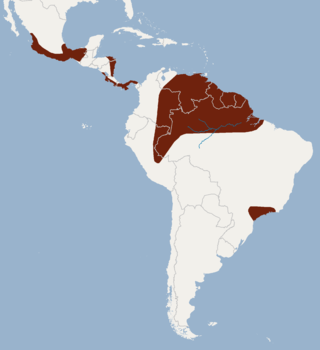
The tricolored big-eared bat is a bat species from South and Central America.

The evergreen toad is a species of toad in the family Bufonidae.
Dermophis glandulosus is a species of caecilian in the family Dermophiidae. It is found in northwestern Colombia, Costa Rica, and Panama. It is the southernmost species among Dermophis.

Dermophis parviceps is a species of caecilian in the family Dermophiidae. It is found in Costa Rica and Panama, and possibly in Colombia, depending on the source. Common names slender caecilian and La Loma caecilian have been coined for it.

Sachatamia albomaculata is a species of frog in the family Centrolenidae. It is found in Honduras, Costa Rica, Panama, western Colombia, and northwestern Ecuador. Its natural habitats are humid lowland and premontane forest from sea level to about 1,500 m (4,900 ft) above sea level. It typically occurs in bushes and trees along forest streams, but populations can persist even along streams in pastures with minimal riparian growth. It is a common species that can locally be threatened by habitat loss but is not facing major threats as a species.
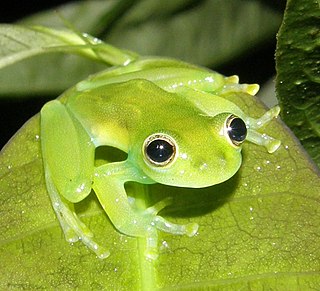
Teratohyla spinosa is a species of frog in the family Centrolenidae. It is found in the Pacific lowlands of northern and central Ecuador and western Colombia, northward on the Pacific slopes Panama and Costa Rica, as well as on the Caribbean slopes of Costa Rica, Nicaragua, and Honduras.
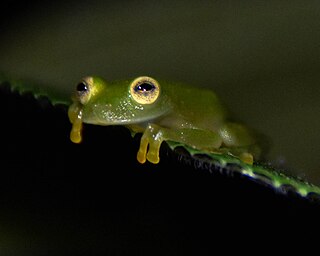
Hyalinobatrachium chirripoi is a species of frog in the family Centrolenidae. It is found in extreme northern Ecuador, northwestern Colombia, Panama, and Costa Rica, as well as in Honduras. The specific name chirripoi refers to the Chirripó Indians inhabiting the area of the type locality, Suretka in the Talamanca canton of Costa Rica. The common name Suretka glass frog has been coined for it.

Allobates talamancae is a species of frog in the family Aromobatidae. It is found in northwestern Ecuador, western Colombia, Panama, Costa Rica, and southern Nicaragua.

Dendropsophus phlebodes, the San Carlos treefrog or San Carlos dwarf treefrog, is a species of frog in the family Hylidae. It is found in western Colombia, Costa Rica, Nicaragua and Panama. Its natural habitats are tropical moist lowland forests, but it may also occur in disturbed habitats. It is threatened by habitat loss.

Scinax elaeochroa, commonly known as the Sipurio snouted treefrog, or olive snouted treefrog, is a species of frog in the family Hylidae. It is found in the Caribbean lowlands of Nicaragua and Panama and in the Pacific lowlands of Costa Rica and Panama, with an isolated population in Colombia.
Pristimantis moro, also known as La Hondura robber frog, is a species of frog in the family Strabomantidae. It is found in lowland western Colombia, the Pacific versant of Panama, and the Atlantic versant of Costa Rica.

The horned marsupial frog, originally named Nototrema cornutum (Boulenger) after the first describer George Albert Boulenger in 1898), is a species of frog in the family Hemiphractidae. It is an arboreal species found in Colombia, Costa Rica, Ecuador and Panama. Its natural habitats are tropical moist lowland forests and montane cloud forests. It is threatened by habitat loss.
Ctenophryne aterrima is a species of frog in the family Microhylidae. It is found in northwestern Ecuador, the Andes of Colombia, and lowland and premontane zones of Panama and Costa Rica to about 1,600 m (5,200 ft) above sea level.

The lanceolated monklet is a species of near-passerine bird in the family Bucconidae, the puffbirds, nunlets, and nunbirds. It is found in Bolivia, Brazil, Colombia, Costa Rica, Ecuador, Panama, and Peru.
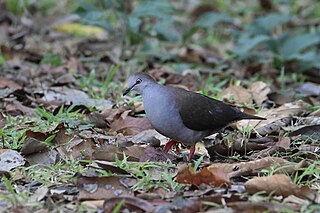
The grey-chested dove is a species of bird in the family Columbidae. It is found in Belize, Colombia, Costa Rica, Guatemala, Honduras, Mexico, Nicaragua, and Panama.
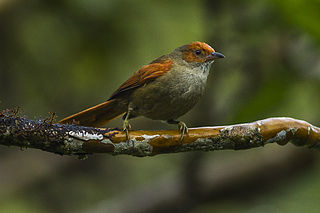
The red-faced spinetail is a species of bird in the Furnariinae subfamily of the ovenbird family Furnariidae. It is found in Colombia, Costa Rica, Ecuador, and Panama.

The spot-crowned antvireo is a species of bird in subfamily Thamnophilinae of family Thamnophilidae, the "typical antbirds". It is found in Colombia, Costa Rica, Ecuador, and Panama.

The scaled antpitta is a species of bird in the family Grallariidae. It is found in Bolivia, Brazil, Colombia, Costa Rica, Ecuador, El Salvador, Guatemala, Guyana, Honduras, Mexico, Nicaragua, Panama, Peru, Trinidad and Tobago, and Venezuela.

The cinnamon woodpecker is a species of bird in subfamily Picinae of the woodpecker family Picidae. It is found in Colombia, Costa Rica, Ecuador, Nicaragua, and Panama.

The Choco broad-nosed bat is a species of bat in the family Phyllostomidae. It is native to Colombia, Panama, and Ecuador, where it is found in the Choco region lowlands. It is threatened by habitat loss. In 2013, Bat Conservation International listed this species as one of the 35 species of its worldwide priority list of conservation.

















